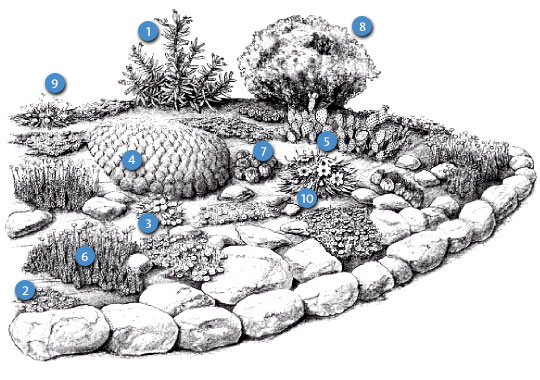A Hardy Succulent Garden
Have you ever toured a garden in the Southwest and wondered how you could possibly re-create some of its succulent glory in your colder, snowier climate? Well, there’s no need to fantasize—just pick or create a nice, sunny, fast-draining spot in your yard and plant some hardy succulents species. This illustration (depicted in early June) is inspired by an actual hardy succulent border in Grand Junction, Colorado, designed by my good friend Don Campbell and the Chinle Cactus and Succulent Society. It achieves four-season beauty by drawing on the full spectrum of hardy succulents. Wide mats of ice plants cover ground, exclude weeds, and provide masses of color from late spring to fall, while shrubby southwestern cacti provide architecture, along with huge, breathtakingly beautiful spring and summer flowers. A drought-tolerant sedum helps fill in the gaps and adds to the spring floral display.
These succulent gems, all of them hardy to at least Zone 5, blend together in a lovely tapestry of textures that’s pleasing even in winter. And since the border needs virtually no water (except during protracted dry spells), it is much less weedy than conventional, watered gardens. I find that most succulent gardens look best with a few non-succulents mixed in. Here, lacy buckwheat, white evening primrose, and a hardy gazania act as textural foils to the succulents and add bright floral color. Though the garden is low maintenance, some initial soil preparation—especially incorporating lots of sand— may be required on your site to achieve the right level of drainage. Applying gravel mulch is also recommended for keeping succulent crowns dry.

Succulents
Cylindropuntia imbricata (walking-stick cholla)
5 feet tall; 4 feet wide
The hardiest of the larger, shrubby cacti from the southern Rocky Mountains, its magenta flowers appear in summer and develop into handsome yellow seedpods that persist until the following year’s bloom. Zones 4 to 11.Delosperma cooperi (hardy purple ice plant)
3 inches tall; 18 inches wide
Native to South Africa, this low-growing plant produces rich purple, daisy-like flowers from May until first frost. The fleshy, cylindrical, dark blue-green foliage is evergreen, giving the plant winter presence. Zones 5 to 9.Delosperma nubigenum ‘Lesotho’ (hardy yellow ice plant)
2 inches tall; 3 feet wide
This ice plant thrives in full sun provided it gets an occasional deep soaking. The Irish-green foliage contrasts nicely with the dominant blues and grays of other succulents, and the shiny yellow spring flowers are dazzling. Zones 4 to 8.Echinocereus coccineus (claret cup cactus)
6 inches tall; 18 inches wide
One of the toughest of the hedgehog cacti, this southwestern U.S. native produces low-growing clusters of thick, spiny, cylindrical gray-green stems. Large coral-red flowers sit atop the stems in early spring. Zones 4 to 9.Opuntia nicholii (Nichol’s prickly pear)
18 inches tall and wide
Of the scores of hardy prickly pears on offer in nurseries nowadays, this stalwart, upright, nearly crimson-red species from northern Arizona is especially refulgent. Zones 4 to 9.Sedum reflexum (blue spruce sedum)
12 inches tall; 10 inches wide
This Mediterranean native’s small light blue-gray leaves are always striking. Its early-summer clusters of chartreuse flowers set off the pink and red blooms of nearby plants. Zones 4 to 9.Sempervivum tectorum (hens and chicks)
4 inches tall; 12 inches wide
This common garden species is extremely heat and drought tolerant—not to mention cold hardy. Sporting rosettes of gray-green foliage, it produces star-shaped red blossoms in summer. Zones 3 to 8.
Nonsucculent Plants
Eriogonum corymbosum (lacy buckwheat)
4 feet tall and wide
This shrubby native forms a large gray mound of foliage and boasts huge, flat-topped white flower clusters in August. Zones 3 to 7.Gazania linearis (treasure flower)
4 inches tall; 15 inches wide
A very hardy South African perennial, it bears dark green, straplike leaves and 3-inch-wide bright yellow summer flowers. Zones 4 to 8.Oenothera caespitosa (white evening primrose)
1 foot tall; 2 feet wide
This western U.S. native forms mounds of gray- green foliage and offers fragrant, white to pink blossoms in early summer. Zones 4 to 9.


